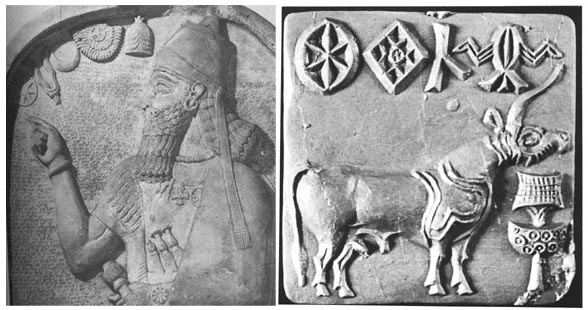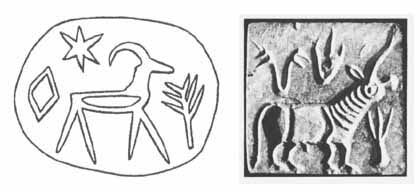Not everything that glitters is gold – and not all ancient symbols were part of writing systems
The Illiterate Harappans, No. 1 – the first of a series of illustrated mini-essays on the Indus symbol system
Text © 2001 Steve Farmer
Below left. King Ashurnasirpal II of Assyria (9th century BCE), pointing to symbols of his patron gods. Some of the same symbols are suspended from his necklace and worn around his wrists as magical amulets; Indus seals were apparently often worn in similar fashions. Reading these Assyrian symbols via written sources, from right to left, starting near Ashurnasirpal’s forehead: a horned crown, emblem of tbe god Ashur or Enlil; a winged sun disk, emblem of Shamash, the ancient sun god and god of justice (a second symbol of Shamash is the cross hanging from Ashurnasipal’s necklace); the crescent moon, emblem of Sin, a moon god; the forked lightning, emblem of Adad, a storm god; and an eight-pointed star, emblem of Ishtar, the fertility and war goddess. Detail of stele in the temple of Ninurta at Nimrod. Cf. J. Black and A. Green, Gods, Demons and Symbols of Ancient Mesopotamia (1992); B.N. Porter, One God or Many (1997: 225).

Above right. Impression of a classical Indus seal (M-6 a in the Corpus of Indus Seals and Inscriptions) from Mohenjo-daro, showing a similar string of what can also be shown to be nonlinguistic symbols – despite eight decades of claims to the contrary. While no written texts exist to help us interpret Indus signs, their original iconic senses, which provide hints of their abstract meanings, can often be determined by comparing all seals that contain pictographic variants of the same sign. Comparisons like this suggest that the ovoid enclosing three intersecting lines (the so-called wheel sign) at the far top left of the seal, also imbedded in miniature in the center of the unidentified structure (a citadel?) to its right, are probably symbols of divine and human power. The second sign from the right, judging fromless stylized examples in other seals, appears to be an ard (a primitive plow used for shallow tillage in semi-arid soils). It presumably represents seasonal or agricultural forces. As we shall see in later notes, a surprisingly high percentage of key Indus symbols are agricultural in nature – one of many clues to the early uses of Indus symbols in sacrificial fertility rituals discussed in upcoming posts. The function of the famous cult object seen below the neck of the “unicorn,” which has long remained a mystery, will also be discussed in those posts.
Below left. Researcher’s drawing of a Palestinian seal from the first half of the first millennium BCE (Keel and Uehlinger, Göttinnen, Götter und Gottessymbole (1992). The drawing has been flipped horizontally to show how it would appear as a seal impression, allowing comparison with the Indus seal impression on the right. On the right. Seal impression M-223 a, from Mohenjo-daro. Comparison of the two seals shows interesting formal simularities seen in agricultural images in many parts of the old world from the third through first millennia BCE. The goat and tree fertility symbols on the Palestinian seal on the left can be traced to Sumerian times. Other fertility symbols on the seal are the sign of Venus and the Egyptian rhomboid. The two symbols on the Harappan seal, as we’ll see in future posts, are both agricultural in nature – representing (from the right to left) a mortar and pestle (used primarily for pounding grain, a bit damaged in this inscription) and an abstract symbol of one of many Indus sacred trees – the most common Indus symbol. (We’ll later see much evidence that is not a “jar” or “cow’s head,” serving as a “genitive suffix” in the supposed Indus writing system, pace I. Mahadevan and A. Parpola.) The plant underneath the primitive “unicorn” in this seal contains some clues to the meaning of the cultic device most commonly found there; this topic will be discussed in future posts.

Below. A few examples of other nonlinguistic symbols from the premodern world. Left: Another seal from Palestine, including local adaptations of the ankh (Egyptian sign of life, on far right in the seal), the Egyptian rhomboid symbol, and various celestial signs. The image emitting rays again apparently represents the planet/god Venus, though in an unusual local variation; the circles represent a stellar group and the deities and terrestial analogs associated with them; from Keel & Uehlinger (1992). Right: Icelandic magical manuscript, with magical runes above and true writing below; the magical runes have been crossed out by a prudent scribe, apparently to neutralize their demonic power. Bottom: A series of geomantic signs associated with the planet Jupiter, from Henry Cornelius Agrippa von Nettesheim, De occulta philosophia 2.51 (1531). Similar nonlinguistic symbol chains show up in innumerable other premodern texts.
Coming next in “The Illiterate Harappans”: Human and animal sacrifice in Indus seals
Feb 2023 format changes from web server migration.
